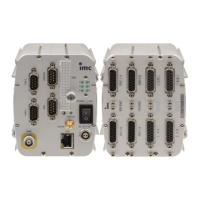© 2018 imc Test & Measurement GmbH
imc C-SERIES - Manual, Version 4 R 3 - 2018-10-19
176 Pin configuration
·
The fuse does not provide complete protection against destruction in the event of a short circuit!
Rather, it serves to limit the current at a slowly increasing load, such as the successive connection of
a large number of imc CANSAS modules. On the other hand, it is not always possible to protect
against very fast increasing currents, such as a hard short-circuit on the cable, safely and quickly
enough!
·
The current limit depends on the operating temperature (internal temperature of the unit):
2.2 A (0°C)
1 A (+70°C)
0.74 A (+85°C)
The corresponding maximum power in the event of a fault (short circuit) then depends on the supply
voltage used.
Guaranteed power available via CAN (Spec: 1 A) up to 70°C indoor temperature
Power consumption reserves:
·
This design guarantees a current of 1 A per node (up to 70°C). In addition, the PTC fuse then slowly
starts limiting the current and "disconnecting" the loads. The generally low consumption of the
CANSAS modules should not be underestimated, since the power is achieved by the current at a low
supply voltage. Even a UNI8 with a power consumption of max. 15 W (with connected sensors)
achieves this limit with a current of 1 A at 15 V. In addition, there is the voltage drop for long cables
and small cross-sections. It is always necessary to first calculate the power consumption and the
expected currents.
·
Due to its technology, the CAN bus is ideally suited for retrofitting a system. It can easily happen
that the current load and the cross-section have been designed correctly at first, but then modules
are added which do not comply with the specification.
USV-buffering:
·
The CAN-supply is not buffered. It is not tapped at the output of the device UPS but directly at the
LEMO power supply. For this reason, this power is not included in any limits for the total device
power, as long as these are decisively determined by the UPS. Since a current and no power
limitation is provided, a UPS buffering would also not be possible without further ado, because with
2 nodes with 1 A current limit (typically!) and a maximum input voltage of 30 V or even 50 V,
considerable power results.
·
Since Power-via-CAN is not coupled to UPS or startup logic, this CAN supply is not deactivated when
the device is switched off, but is always active as soon as the main supply (LEMO) is powered.
Reference:
·
The CAN supply voltage is identical to the main power supply (wide range, LEMO) and has
corresponding potential reference. The pins on the DSUB-9 are marked with ±CAN_SUPPLY.
·
In contrast, the pin "CAN-GND" has nothing to do with this: This is rather the electrical and logical
completely independent reference of the CAN bus signals. It is electrically isolated from the rest of
the system (housing, power supply, system electronics). CAN_GND should always be used
independently of the power supply so that the CAN_H and CAN_L levels are reliably detected.

